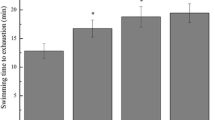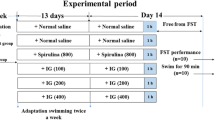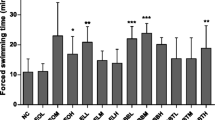Abstract
Swimming enhancement effects of ethanol extract from ripe Rubus coreanus (RCE) fruits were investigated in mice. An Ex-RCE group was orally administered 1 g/kg body weight/day of RCE. An Ex-Control group received distilled water for 28 days. Exhaustive swimming times were significantly (p<0.05) prolonged in Ex-RCE mice, compared with Ex-Control mice. Ex-RCE mice had lower lactate and higher glucose levels after exhaustive swimming. Plasma non-esterified fatty acid levels in Ex-RCE mice were significantly (p<0.05) increased during swimming, compared with Ex-Control. Lower plasma triglyceride levels were shown in Ex-RCE mice after swimming. Ex-RCE mice exhibited higher muscle glycogen and lower malondialdehyde levels, compared with Ex-Control mice. RCE is a useful agent for enhancement of the swimming capacity and amelioration of physical fatigue via a decrease in lactate accumulation, and supply of energy sources via glycogen sparing and facilitation of fat use, and reduction of lipid peroxidation levels through swimming.
Similar content being viewed by others
References
Deldicque L, Francaux M. Functional food for exercise performance: Fact or foe? Curr. Opin. Clin. Nutr. Metab. Care 11: 774–781 (2008)
Mizunoya W, Haramizu S, Shibakusa T, Okabe Y, Fushiki T. Dietary conjugated linoleic acid increases endurance capacity and fat oxidation in mice during exercise. Lipids 40: 265–271 (2005)
Murase T, Haramizu S, Shimotoyodome A, Tokimitsu I. Green tea extract improves endurance capacity and increases muscle lipid oxidation in mice. Am. J. Physiol. Regul. Integr. Comp. Physiol. 288: 708–715 (2005)
You Y, Kim K, Heo H, Lee K, Lee J, Shim S, Jun W. Stimulatory effects of Pseudosasa japonica leaves on exercise performance. Biosci. Biotech. Bioch. 70: 2532–2535 (2006)
Lancha AH, Recco MB, Abdalla DSP, Curi R. Effect of aspartate, asparagines, and carnitine supplementation in the diet on metabolism of skeletal muscle during a moderate exercise. Physiol. Behav. 57: 367–371 (1995)
Ishihara K, Yamada A, Mita Y, Goto A, Ishimi T, Mabuchi H, Inoue K, Fushiki T, Yasumoto K. Improved swimming pool achieves higher reproducibility and sensitivity to effect of food components as ergogenic AIDS. J. Nutr. Sci. Vitaminol. 55: 301–308 (2009)
Aoi W, Naito Y, Yoshikawa T. Exercise and functional foods. Nutr. J. 5: 1–8 (2006)
Fitts RH. Cellular mechanism of muscle fatigue. Physiol. Rev. 74: 49–94 (1994)
Coombes JS, Rowell B, Dodd JM, Demirel HA, Naito H, Shanely RA, Powers SK. Effects of vitamin E deficiency on fatigue and muscle contractile properties. Eur. J. Appl. Physiol. 87: 272–277 (2002)
You L, Zhao M, Regenstin JM, Ren J. In vitro antioxidant activity and in vivo anti-fatigue effect of loach (Misgurnus anguillicaudatus) peptides prepared by papain digestion. Food Chem. 124: 188–194 (2011)
You Y, Park J, Yoon H, Lee Y, Hwang K, Lee J, Kim K, Lee K, Shim S, Jun W. Stimulatory effects of ferulic acid on endurance exercise capacity in mice. Biosci. Biotech. Bioch. 73: 1392–1397 (2009)
Shim S, Chung J, Lee J, Hwang K, Sone J, Hong BS, Cho HY, Jun W. Hepatoprotective effects of black rice on superoxide anion radicals in HepG2 cells. Food Sci. Biotechnol. 15: 993–996 (2006)
Sawa T, Akaike T, Maeda H. Tyrosine nitration by peroxynitrite formed from nitric oxide and superoxide generated by xanthine oxidase. J. Biol. Chem. 275: 32467–32474 (2000)
Xu J, Li Y. Effects of salidroside on exhaustive exercise-induced oxidative stress in rats. Mol. Med. Rep. 6: 1195–1198 (2012)
Yu SH, Huang HY, Korivi M, Hsu MF, Huang CY, Hou CW, Chen CY, Kao CL, Lee RP, Lee SD, Kuo CH. Oral Rg1 supplementation strengthens antioxidant defense system against exercise-induced oxidative stress in rat skeletal muscles. J. Int. Soc. Sports Nutr. 9: 23 (2012)
Lim JW, Hwnag HJ, Shin CS. Polyphenol compounds and anti-inflammatory activities of Korean black raspberry (Rubus coreanus Miquel) wines produced from juice supplemented with pulp and seed. J. Agr. Food Chem. 60: 5121–5127 (2012)
Jeon SK, Lee JW, Lee IS. Effect of antioxidant activity and induction of DNA damage on human gastric cancer cell by Rubus coreanus Miquel. J. Life Sci. 17: 1723–1728 (2007)
Lee S, You Y, Yoon HG, Kim K, Park J, Kim S, Ho JN, Lee J, Shim S, Jun W. Fatigue-alleviating effect on mice of an ethanolic extract from Rubus coreanus. Biosci. Biotech. Bioch. 75: 349–351 (2011)
Matsumoto K, Ishihara K, Tanaka K, Inoue K, Fushiki T. An adjustable-current swimming pool for the evaluation of endurance capacity of mice. J. Appl. Physiol. 81: 1843–1849 (1996)
Gierus M, Rocha JB. Forage substitution in a grain-based diet affects pH and glycogen content of semimembranosus and semitendinosus rabbit muscles. J. Anim. Sci. 75: 2920–2924 (1997)
Draper HH, Hadley M. Malondialdehyde determination as index of lipid peroxidation. Method. Enzymol. 186: 421–431 (1990)
Bradford MA. A rapid and sensitive method for the quantitation of microgram quantities of protein utilizing the principle of protein-dye binding. Anal. Biochem. 72: 248–254 (1976)
Moriura T, Matsuda H, Kubo M. Pharmacological study on Agkistrodon blomhoffii blomhoffii BOIE. V. anti-fatigue effect of the 50% ethanol extract in acute weight-loaded forced swimming-treated rats. Biol. Pharm. Bull. 19: 62–66 (1996)
Jung KA, Kim IH, Han DS. Effect of medicinal plant extracts on forced swimming capacity in mice. J. Ethnopharmacol. 93: 75–81 (2004)
Medbo JI. Glycogen breakdown and lactate accumulation during highintensity cycling. Acta Physiol. Scand. 149: 85–89 (1993)
Jones NL, Havel RJ. Metabolism of free fatty acids and chylomicron triglycerides during exercise in rats. Am. J. Physiol. 213: 824–828 (1967)
Ikeuchi M, Yamaguchi K, Koyama T, Sono Y, Yazawa K. Effects of fenugreek seeds (Trigonella foenum greaecum) extract on endurance capacity in mice. J. Nutr. Sci. Vitaminol. 52: 287–292 (2006)
Dohm GL, Tapscott EB, Barakat HA, Kasperek GJ. Influence of fasting on glycogen depletion in rats during exercise. J. Appl. Physiol. 55: 830–833 (1983)
Rennie MJ, Winder WW, Holloszy JO. A sparing effect of increased plasma fatty acids on muscle and liver glycogen content in the exercising rat. Biochem. J. 156: 647–655 (1976)
Márquez R, Santángelo G, Sastre J, Goldschmidt P, Luyckx J, Pallardó FV, Viña J. Cyanoside chloride and chromocarbe diethylamine are more effective than vitamin C against exercise-induced oxidative stress. Pharmacol. Toxicol. 89: 255–258 (2001)
Powers SK, Jackson MJ. Exercise-induced oxidative stress: Cellular mechanisms and impact on muscle force production. Physiol. Rev. 88: 1243–1276 (2008)
You Y, Kim K, Yoon HG, Lee KW, Lee J, Chun J, Shin DH, Park J, Jun W. Chronic effect of ferulic acid from Pseudosasa japonica leaves on enhancing exercise activity in mice. Phytother. Res. 24: 1508–1513 (2010)
Lee S, You Y, Kim K, Park J, Jeong C, Jhon D, Jun W. Antioxidant activities of native Gwangyang Rubus coreanus Miq. J. Korean. Soc. Food Sci. Nutr. 41: 327–332 (2012)
Swamy MS, Sivanna N, Tamatam A, Khanum F. Effect of poly phenols in enhancing the swimming capacity of rats. Funct. Foods Health Dis. 1: 482–491 (2011)
Author information
Authors and Affiliations
Corresponding author
Rights and permissions
About this article
Cite this article
You, Y., Kim, K., Jeong, H. et al. Ethanolic extract from Rubus coreanus enhanced swimming capacity in mice. Food Sci Biotechnol 24, 2213–2217 (2015). https://doi.org/10.1007/s10068-015-0295-5
Received:
Revised:
Accepted:
Published:
Issue Date:
DOI: https://doi.org/10.1007/s10068-015-0295-5




